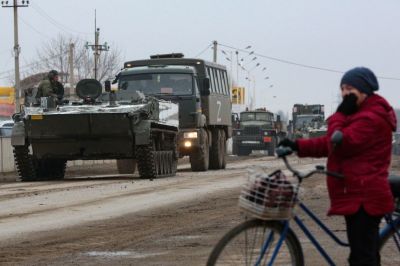Military observations of the Russian invasion

Russian President Vladimir Putin surprised many around the world last week by invading Ukraine from multiple directions. Of particular concern, from the southern border of Belarus straight towards the nearby Ukrainian capital, Kyiv. Having served in mechanized, light (including Ranger Training) infantry, with operational deployments over a 30-year infantry officer career, I would like to offer the following observations about Russia's invasion of Ukraine.
We saw rocket and air attacks against various targets throughout Ukraine. Previously, Putin had followed the “Gerasimov Doctrine,” which involved making strategic gains with “nonmilitary means...supplemented by military means of a concealed character,” according to namesake and Russian Chief of the General Staff Valery Gerasimov. The ground invasion was anything but concealed military means and constituted naked aggression. The primary thrust of the attack was with armored and mechanized forces.
Putin has wanted to invade Ukraine to install a pro-Russian administration for many years. Since the 2014 “Color Revolution” in Ukraine, resulting in a Ukrainian administration much less aligned with Russian interests, Putin has signaled this desire directly and indirectly. Shortly after this Color Revolution, Russia bloodlessly seized Crimea from Ukraine and then openly supported Russian separatists in the Eastern Donbass region. Still, Putin perceived the costs of an actual invasion of Ukraine as outweighing the gains.
Unfortunately, deterrence has failed after the catastrophically botched withdrawal from Afghanistan in 2021. Deterrence comes from the perception that gains of a certain course of action will not be worth the costs. Just over a month after the botched withdrawal, Reuters reported the following about Putin’s perceptions of that failure: “The United States' involvement in Afghanistan has led to tragedy, Russian President Vladimir Putin said on Wednesday, one week before Russia is due to host the Taliban in Moscow.” Hosting the Taliban and making other such pronouncements of perceived American weakness showed the change in Putin’s thinking after Afghanistan. Putin believed the United States would react similarly to what he saw with Afghanistan, and invading Ukraine became worth the cost he foresaw from Biden. Additionally, Putin saw America move from an oil surplus to dependence on Russian oil under Biden, further lessening deterrence.
At the operational and tactical levels, the invasion has shown a number of problems with the Russian military. The terrain of Ukraine, particularly in winter, lends toward using armored and mechanized as happened. A major challenge of armored/mech forces is the substantial level of fuel required, along with ammunition, parts, and other supplies. Among seasoned military leaders, there’s an old refrain, “Amateurs talk operations, and professionals talk logistics.” Logistics becomes the greatest challenge and the show-stopper, particularly as operations can only succeed with proper logistics. I found this quite true in my experience with mechanized infantry and armor. Planning and capabilities are critical.
Based on the size of the respective militaries, Russian should have seized Kyiv and toppled the Ukrainian government within days of the start of the invasion. Russia is the second most powerful military in the world (in terms of capabilities) and Ukraine is ranked at only twenty-two according to Global Firepower. Russia spent $61.7 billion on its military (2020), and has a total military of 850,000 personnel, while Ukraine's is only 250,000. Russia dwarfs Ukraine in airpower, with 4100 aircraft to Ukraine’s 318. These same levels of imbalance exist with most other weapons platforms, like tanks. Russia quickly fired over 250 ballistic and cruise missiles at targets throughout Ukraine at the start. Seizing urban areas, like Kyiv, can be quite difficult, as cities require high numbers of troops and give an advantage to defenders. Still, a rapid Russian assault was meant to quickly overwhelm and bring capitulation before becoming bogged down.
Despite their overwhelming advantages, the Russian advance has stalled. Part of the answer appears to be stiff Ukrainian resistance, but the main problem seems to be logistics. Multiple reports have appeared about Russian armor stopping due to lack of fuel, not only because of the lack of resupply but Russian vehicles moving out from Belarus without being topped off. As Philip G. Wasielewski and Seth Jones of The Center for Strategic and International Studies have reported, “Russian army logistics forces are not designed for large-scale ground offensives far from railroads.” Beyond that structural problem, logistics planning was substandard. According to The Jerusalem Post: “After four days of heavy fighting and hundreds of kilometers of driving, Russian forces must resupply (ammunition and personnel) and refuel. An American official said on Saturday that Russian leaders are 'increasingly frustrated' with how the invasion has gone so far and according to the British Defense Ministry, 'the speed of the Russian advance has temporarily slowed likely as a result of acute logistical difficulties and strong Ukrainian resistance.'"
We praise Ukraine’s resistance against the Russian onslaught, but we have a duty to learn from these lessons. After the horrendous withdrawal from Afghanistan, we held nobody accountable and that was wrong. Adversaries like Russia and China watched, as they also watched us lose energy independence. It’s time to take a closer look at adversary logistical capabilities and understand potential weaknesses. We should also look to our own ability to conduct large-scale conventional operations successfully, something we haven’t faced for many years. The world is a tough and dangerous place, and we must get tougher and stronger.
Bill Connor, a retired Army Infantry colonel, author and Orangeburg attorney, has deployed multiple times to the Middle East. Connor was the senior U.S. military adviser to Afghan forces in Helmand Province, where he received the Bronze Star. A Citadel graduate with a JD from USC, he is also a Distinguished Graduate of the U.S. Army War College, earning his master of strategic studies. He is the author of the book Articles from War.




















